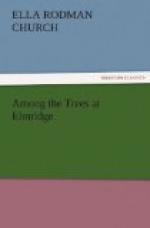[Illustration: AMERICAN BEECH.]
“A very good idea,” replied his governess, laughing; “only you must not spell it with an a, like the seashore, for it is b-e-e-c-h.—The fluted, or ribbed, shaft of this grand-looking tree is often sixty or seventy feet high, and, although it is found in its greatest perfection in England, it is a common tree in most of the woods in this country. For depth of shade no tree is equal to the beech, and its long beautiful leaves, with their close ridges and serrated edges, are very much like those of the chestnut. The leaves are of a light, fresh green and very neat and perfect, because they are so seldom attacked by insects; they remain longer on the branches than those of any deciduous tree, and give a cheerful air to the wood in winter. In the autumn they change to a light yellow-brown, which makes a pretty contrast to the reds and greens and purples of other trees. The branches start out almost straight from the tree, but they very soon curve and turn regularly upward. Every small twig turns in the same direction, making the long leaf-buds at the end look like so many little spears. I showed you these ‘stuck-up’ buds when we were looking at the tree, and you noticed how different they were from the other trees.”
Yes, the children remembered it; and it always seemed to them particularly nice to have part of the talk out of doors and the rest in the house.
“Doesn’t the beech tree have nuts?” asked Malcolm. “John says it does.”
“Yes,” replied Miss Harson; “it has tiny three-cornered nuts which seem particularly small for so large a tree. But these nuts are eagerly devoured by pigeons, partridges and squirrels. Bears are said to be very fond of them, and swine fatten very rapidly upon them. Most varieties are so small as not to repay the trouble of gathering, drying and opening them. Fortunately, this is not the case with all, as it is a delicious nut. In France the beech-nut is much used for making oil, which is highly valued for burning in lamps and for cooking. In parts of the same country the nuts, roasted, serve as a substitute for coffee.”
“I’d like to find some when they’re ripe,” said Clara, “if they are little.”
“We will have a search for them, then,” was the reply, “when the time comes.—The flowers which produce these little nuts are very showy and grow in roundish tassels, or heads, which hang by thread-like, silky stalks, one or two inches long, from the midst of the young leaves of a newly-opened bud. A traveler says of these leaves, ’We used always to think that the most luxurious and refreshing bed was that which prevails universally in Italy, and which consists entirely of a pile of mattresses filled with the luxuriant spathe of the Indian corn; which beds have the advantage of being soft as well as elastic, and we have always found the sleep enjoyed on them to be particularly sound and restorative.




